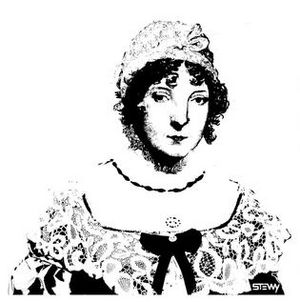Sarah Guppy facts for kids
Quick facts for kids
Sarah Guppy
|
|
|---|---|

Stencil by Stewy from a portrait by Isambard Kingdom Brunel
|
|
| Born |
Sarah Maria Beach
5. November 1770 Birmingham, England
|
| Died | 24 August 1852 (aged 81/82) Clifton, Bristol, England
|
| Nationality | English |
| Spouse(s) |
|
| Children | Samuel Guppy, Jr. (1795–1875), Thomas Richard (1797–1882), Sarah Maria Ann (1801– ), Mary Elizabeth (1806–1841), Robert (1808– ), Grace (1809–1838). |
| Engineering career | |
| Discipline | Inventor |
| Significant design | A tea or coffee urn that also cooked eggs, the fire hood, a candlestick that made candles burn longer |
| Significant advance | Improvements in ship caulking and barnacle prevention |
Sarah Guppy, born Sarah Beach (1770–1852), was an English inventor. She was the first woman to get a patent for a bridge design in 1811. Sarah also created many other useful items for homes and ships.
Some people have mistakenly said that Sarah Guppy designed the Clifton Suspension Bridge. This famous bridge was actually designed by Isambard Kingdom Brunel. Sarah did patent her own ideas for a chain bridge in 1811. This was before the competition for the Clifton bridge even started. However, her bridge design was never built. Brunel's design was very different from Sarah's. His bridge used flat iron bars to hang the deck, not chains like Sarah's. Also, Brunel's bridge was built on solid rock high above the river. Sarah's design included foundations in the riverbed.
Sarah Guppy was very generous with her inventions. She cared more about helping people than getting rich or famous. For example, she helped a lot with the design of Thomas Telford's Menai Bridge. Sarah let Telford use her ideas for free. She contributed much to this bridge, but making money was not her main goal.
Contents
Early Life and Clever Ideas
Sarah Maria Beach was born in Birmingham, England. She was baptized in November 1770. Her parents were Richard and Mary Beach. In 1795, she married Samuel Guppy.
In 1811, Sarah received her first patent. It was for a new way to build strong foundations for bridges. Thomas Telford, a famous engineer, asked to use her design for his suspension bridge foundations. Sarah said yes and let him use it for free.
Sarah was also a friend of Isambard Kingdom Brunel and his family. She became involved with the Great Western Railway. She would write to the railway directors with her ideas and support. In 1841, she suggested planting willows and poplars. These trees would help keep the railway embankments stable. Sarah kept giving technical advice, even though she felt it was "unpleasant to speak of oneself—it may seem boastful particularly in a woman."
Sarah's early life helped her succeed. She came from a wealthy family and received a good education. She was also surrounded by creative thinkers. When she married Samuel Guppy, he built machinery. This allowed Sarah to learn about business and engineering. Samuel supported Sarah's interest in engineering. He even let her handle important business deals for his manufacturing company. This showed he respected her abilities.
Family Life
After marrying Samuel Guppy, a merchant from Bristol, they lived in fancy areas like Queen Square. They were important people in Bristol and Clifton society.
Sarah and Samuel had six children. Their sons, Thomas Richard and Samuel Jr., ran a sugar refinery in Bristol. Thomas Richard later became an engineer and worked with Brunel. He helped a lot with the design of the famous ships SS Great Western and SS Great Britain. Brunel even painted a portrait of Sarah's daughter, also named Sarah, around 1836.
Later Years
In 1837, Sarah's husband Samuel passed away. Sarah, who was 67, then married Richard Eyre Coote. He was 28 years younger than her. For a while, they lived at Arnos Court. However, Richard spent Sarah's money very quickly, often on horses. He also did not pay much attention to her.
In 1842, Sarah moved to 7 Richmond Hill, Clifton. She bought the land across from her house. She wanted it to be a green space for everyone in Clifton to enjoy. This area is still a park today.
Sarah Guppy's later life had some challenges. Her second marriage was difficult, as her younger husband spent her money. She eventually left Richard Coote and lived on her own. Sarah, an inspiring woman who contributed much to the world, passed away in 1852 at age 81. She had only 200 pounds left to her name.
Sarah Guppy's Lasting Impact
Female inventors in the 1800s were often not recognized. To even become an inventor, women needed more than just a good idea. Sarah Guppy used all her resources. She combined this with her strong motivation, drive, and curiosity. She was unique and did not let traditional gender roles stop her. She acted on her ideas and made a real difference in society.
Today, her early suspension bridge design helped pave the way for modern bridges. Her ideas formed a starting point for others to build upon. The Clifton Suspension Bridge might not exist without Sarah Guppy's contributions. She was modest and did not seek full credit. Her main goal was to make a positive change for the world.
Images for kids
See also
 In Spanish: Sarah Guppy para niños
In Spanish: Sarah Guppy para niños



